It’s Halloween, and while some try to avoid the scary theme of the holiday, there’s just something about getting lost in a spooky title that makes the day so much fun. But bats and spiders aside, this is a great time to go through your library and find that title you’ve neglected. Our staff and readers have done just that, so read on and see what they’ve been playing in October!
Mansion of Hidden Souls By Ken Horowitz
 I’ve written about this one before, but that’s only because I feel it’s so underrated. The lonely atmosphere the game projects while playing and the elegant settings to be explored all make for an engaging adventure that I find myself coming back to again and again. Moving from room to room in full-motion video works a lot better than one would initially think. There’s not much interactivity in the different settings, and the whole experience is only a few hours long, but everything comes together well enough to keep you playing until the end. To me, that’s all a game really needs to do.
I’ve written about this one before, but that’s only because I feel it’s so underrated. The lonely atmosphere the game projects while playing and the elegant settings to be explored all make for an engaging adventure that I find myself coming back to again and again. Moving from room to room in full-motion video works a lot better than one would initially think. There’s not much interactivity in the different settings, and the whole experience is only a few hours long, but everything comes together well enough to keep you playing until the end. To me, that’s all a game really needs to do.
Mansion of Hidden Souls is also compatible with the Mega Mouse, and the difference this makes in gameplay cannot be overstated. It controls like a dream when using the mouse, and an already satisfying game becomes one of the most gratifying experiences the Sega CD has to offer. Trust me. You won’t ever look at butterflies the same way again after playing this.
Wolfchild By Sebastian Sponsel
I guess Halloween is as good a time as any to direct some attention to an often overlooked action platformer. Not that Wolfchild was an unforgettably awesome title that you absolutely must have played once in your life, but it is a fairly decent action game in the Turrican vein that, while it doesn’t break any new ground, is definitely worth a look or two.
 If you’re just looking for adequately spooky stuff to play after dark, stages two and three of the rather short game should do nicely. You’re running as a buff, genetically altered werewolf though a spooky forest with alienesque trees and swamp monster-inspired cyborgs, and a bug-infested castle full of spiderwebs and insectoid enemies respectively. The soundtrack of the Sega CD version in particular does a good job of creating a suitably enjoyable atmosphere. The visuals aren’t perfect. You can see the Amiga home computer roots of the game in the somewhat washed-out graphics that look like the are missing a few colors, but for those two levels, the dark look actually fits the mood quite well. Too bad that these good impressions don’t carry over into the final two levels, where it seems the developers ran out of ideas and you’re only running through overly long, techno-styled corridors fighting the same waves of cyborgs over and over again. So if you’re just looking for some atmospheric gaming for Halloween night, you might as well turn off the console after stage three. Or you might as well keep on playing – with five stages, the game isn’t too big, and after you get a hang of its controls it ain’t that hard to beat from that point onward. And like I said, the game is quite decent, and the Sega CD soundtrack ain’t bad at all, so it’s worth giving the game a shot.
If you’re just looking for adequately spooky stuff to play after dark, stages two and three of the rather short game should do nicely. You’re running as a buff, genetically altered werewolf though a spooky forest with alienesque trees and swamp monster-inspired cyborgs, and a bug-infested castle full of spiderwebs and insectoid enemies respectively. The soundtrack of the Sega CD version in particular does a good job of creating a suitably enjoyable atmosphere. The visuals aren’t perfect. You can see the Amiga home computer roots of the game in the somewhat washed-out graphics that look like the are missing a few colors, but for those two levels, the dark look actually fits the mood quite well. Too bad that these good impressions don’t carry over into the final two levels, where it seems the developers ran out of ideas and you’re only running through overly long, techno-styled corridors fighting the same waves of cyborgs over and over again. So if you’re just looking for some atmospheric gaming for Halloween night, you might as well turn off the console after stage three. Or you might as well keep on playing – with five stages, the game isn’t too big, and after you get a hang of its controls it ain’t that hard to beat from that point onward. And like I said, the game is quite decent, and the Sega CD soundtrack ain’t bad at all, so it’s worth giving the game a shot.
Oh, but should you want to get yourself into the right Halloween mood, you’d better skip the cartoon intro at the beginning. Yeah, it shows our protagonist turning himself into a werewolf, but the animation is grade-school-level amateurish that at best you might end up giggling hysterically instead of getting in the mood for some gloomy action.
A-WOOOOOOOOOO.
UndeadLine By The Coop
Zombies. Ghosts. Skeletons. Demons. Monsters. Guns! Guns! Guns! C’mon Sal! The Tigers are playing… (thumps table three times)… tonight! Wait… what? Anyway, the undead. They’re all the rage these days, whether they’re actual undead who rose from their earthen graves, mutated humans that resemble them, or freakish outer space monstrosities that rotted where they feel. Gamers love to kill them, and game makers love to stick them in when given the chance. But back in the Genesis era, the undead weren’t nearly as prevalent as they are now. Sure, we had our Ghouls ‘N Ghosts, our Zombies Ate My Neighbors, our Splatterhouses and Castlevanias, but compared the sheer volume of other titles being put out back then, they were definitely in the minority in terms of game antagonists. Even more so when it came to shmups. But, there were a few shmups that decided to go the undead route, and one of them, was a Japan-only title called UndeadLine.
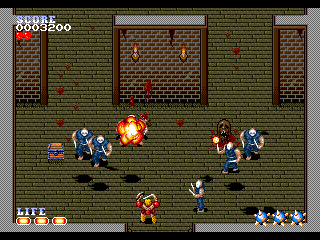 You’ve got it all in this game. Slaughtered villagers, demons, ghosts, skeletons, haunted objects… it all gets thrown at you as you try to make your way through this game. Various power-ups are around to collect, and big bosses are set to meet and greet you at the end of the levels, where you’ll even face versions of a couple of Castlevania staples; a vampire and a grim reaper. Every level and boss will do everything in their power to stop you, and holy hell do they mean business.
You’ve got it all in this game. Slaughtered villagers, demons, ghosts, skeletons, haunted objects… it all gets thrown at you as you try to make your way through this game. Various power-ups are around to collect, and big bosses are set to meet and greet you at the end of the levels, where you’ll even face versions of a couple of Castlevania staples; a vampire and a grim reaper. Every level and boss will do everything in their power to stop you, and holy hell do they mean business.
This is not an easy game… at all. Even on the easiest settings, it will kick your ass readily, and at times, handsomely. Between enemies that move at a good clips, bullets, falling objects, and the ground itself at times, there’s a lot trying to stop you. And with only three bars of life, it doesn’t take long to kill you. Granted, you can pick up shields, health restore, and use a shield to block enemy shots, but until you learn the patterns and such, expect those things to only prolong your life by a little. Thankfully, the game can’t base its difficulty on poor controls or bad hit detection, as both are pretty good. It’s just a lot coming at you from all sides, and you have to have the right weapon at the right time.
So yeah, hard game, the dead, monsters… all the ingredients for a Halloween game that’ll have you cursing, whether it’s a horrible night or not. UndeadLine‘s also got good graphics, some good music, and it’s just about right in terms of how long it takes to beat the game. There’s also a translation patch out there, making it so you can read the in-game text. I know the title might make some think of a zombie hoedown, or ghouls doing river dance, but if you like shmups, fighting the dead, and want a challenge, go find it and play it. Just try not to throw a fit that results in your controller qualifying for frequent flier miles.
Todd’s Adventures in Slime World By Goldenband
I spent this past week playing through this Renovation release, and let’s get one thing clear: Todd’s Adventures in Slime World is a plug-ugly, frustrating game with aggravating controls, a poor framerate, sadistic stage design, offensively grating sound effects, and tedious, overlong levels that seem to go on five times longer than they should.
But to quote Andy Roddick circa January 2007, “Other than that, it was fine.”
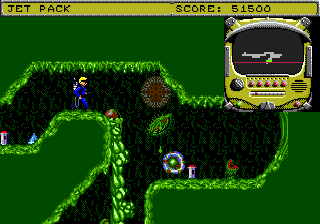 To be less facetious: if you can get past the game’s horrorshow exterior, there’s a core of addictive gameplay at the heart of this acne-themed puzzle-platformer (best known in its version on the Atari Lynx). You’ll surely spend a lot of time banging your head against the wall, but since all but one of its scenarios offer unlimited lives and hexadecimal passwords for every room, you seldom have to break through the same wall twice. I found myself willing to stick with Todd through each of his adventures, from the fiendishly nasty Logic level in which he’s completely unarmed, to the brutally unforgiving Arcade level where one mistake means starting over from scratch.
To be less facetious: if you can get past the game’s horrorshow exterior, there’s a core of addictive gameplay at the heart of this acne-themed puzzle-platformer (best known in its version on the Atari Lynx). You’ll surely spend a lot of time banging your head against the wall, but since all but one of its scenarios offer unlimited lives and hexadecimal passwords for every room, you seldom have to break through the same wall twice. I found myself willing to stick with Todd through each of his adventures, from the fiendishly nasty Logic level in which he’s completely unarmed, to the brutally unforgiving Arcade level where one mistake means starting over from scratch.
Still, it sure is an ugly one. No doubt some degree of distastefulness was to be expected from a game that coats practically every surface (including your player) in a thick layer of snot-like slime, as if Marc Summers’s worst nightmares had come true. However, the designers go further than that, and seem determined to ensure that nothing about Todd’s Adventures in Slime World could remotely be considered attractive. In the audio department they were particularly driven to ensure maximum repulsion, pushing the Genesis’s FM synth into its ugliest and most inharmonic timbres, and pairing the game’s most annoying event – getting eaten by an undetectable Hidden Snapper – with its most abrasive sound, a caustic rush of noise that’s twice as loud as anything else.
For brave and tolerant souls only, then, and if you have a copy of Todd’s Adventures in Slime World in your collection it should be kept in a bell jar, behind a locked door with “Lasciate ogni speranza, voi che giocate”written overhead in the archway. Even so, if you’re willing to take the risk, you might find yourself strangely compelled to see it through. Just remember, in every horror movie, it’s usually the ugly ones who get axed first…so don’t let Todd’s slimy Adventures rub off on you too much.
By the way, if you want a laugh, check out the PC Engine CD version on Youtube. The game’s audio is replaced with a bumpin’ redbook soundtrack, and the levels are now punctuated with animated cut scenes that veer between the skeevy and the hilariously overwrought. It’s all a bit much for a silly game about zits and slime.
Castle of Illusion Starring Mickey Mouse By Joseph C.
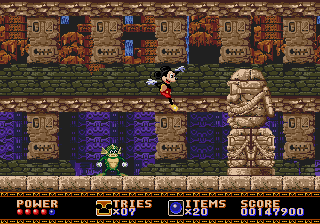 I suppose it would be more proper to say that I’ve been playing the recently released remake but I did play the original as it was released free on PSN with a pre-order of the update. The remake itself is excellent, serving more as a compliment to the original. It enhances elements while still leaving the original well worth playing.
I suppose it would be more proper to say that I’ve been playing the recently released remake but I did play the original as it was released free on PSN with a pre-order of the update. The remake itself is excellent, serving more as a compliment to the original. It enhances elements while still leaving the original well worth playing.
I’m sorry to say that I still haven’t beaten the original as of writing. I have been all the way through the excellent sequel but I only ever played a few levels into this one. With the remake complete, I felt it was time I finally did. I’m still early in the game but after experiencing the remake it really has helped me to appreciate what a fantastic platformer it is. From its beautiful art style and whimsical music obscuring the darker tone of the game; to the careful platforming that can be hard to appreciate at first to those who started out (like me), with Sonic The Hedgehog.
Castle of Illusion truly is an imaginative masterpiece that set the standard for the many excellent Disney platformers that followed. I hope I’ll be able to write more soon after finally beating the game. For those that have, I’d recommend the remake if you haven’t tried it already.
Mary Shelley’s Frankenstein By David Dyne
This year I promised myself I was going to play some horror themed titles on the Genesis during the month of October, and initially I planned to check out Dracula Unleashed on the Sega CD but then switched it up at the last moment and went for Mary Shelley’s Frankenstein instead. I’ll have to go back some time and watch the film again it’s based on, as I don’t recall much about it other than Robert DeNiro playing the monster and Kenneth Branagh as Doctor Frankenstein. Being a Hammer film fan my favorite incarnation of the good doctor will always be Peter Cushing.
This game on the Genesis and SNES, along with the film it’s based on, have been panned for a plethora of reasons that have been well documented elsewhere, so you’d assume it’s another title in a long line of licensed garbage that should be avoided like the plague. Consider me infected then, as this game can be fun provided you put some time into learning the mechanics of item collection, puzzle solving, platforming and whacking people and creatures with a stick.
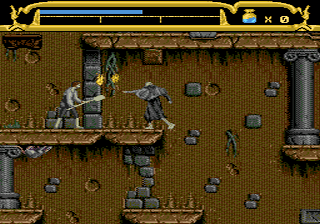
Exploration is the name of the game here as you’ll be scouring levels for items to combine to solve puzzles to progress further, open up hidden areas replete with power ups and avoid boss battles if you choose. With scant information in the manual on the item system, it felt like an old school PC game that threw you to the wolves and expected you to figure out how to survive, a feature that modern games are sorely lacking. Even though I finished the game I still have no idea what some of the items were used for and even the scant video walkthroughs on YouTube don’t cover everything. For example, in the first stage you can pick up a leather satchel, a gentlemen’s hat, and brass key, along with other necessary items. The brass key should be used to unlock a door like the iron key you find earlier, but I couldn’t find any brass door despite numerous playthroughs of the level, nor could I figure out any use for the hat or satchel. It’s not as if the monster can wear the hat and disguise himself, or can he? In the second stage you’ll find a workman’s pick early which also doesn’t seem to have a use anywhere on the stage. I also missed out on setting some of the gas clouds on fire in stage three as I couldn’t locate any sources of flame to light my whacking stick on fire. I still intend to go back and try to solve some of the puzzles that I missed out on, like the secret crypt in stage two that requires some heraldry symbols to unlock, locating the rest of pieces of the raft in stage five, and figuring how to exit the bottom of the ship in stage six so I can bring the crow’s nest down for a full health recharge before the final boss battle (you’ll need every ounce of energy to survive against the ship’s captain).
The best aspect of the game has to be its soundtrack. From the monster’s flight from the town of Ingolstadt in stage one to the spooky exploration of the darkened crypt in stage two to the ice flows in the arctic, each level has its own unique feel. The Streets of Ingolstadt and Frankenstein’s Mansion are my two favorite selections from this one.
Light Crusader By Frank Villone
Browsing my collection for a title with some paranormal elements (for a 16-bit celebration of Halloween), I remembered some spookiness in Light Crusader, which I had started in the past. From the title screen, there is a rich, dramatic soundtrack, which gives a unique atmosphere to every part of the game. The art style is colorful, detailed, and mostly realistic, with lots of small special effects all throughout.
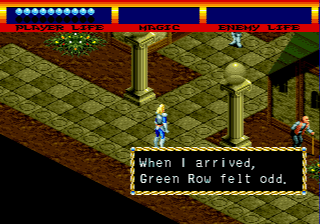 In the past, I enjoyed starting out and wandering the village, having funny conversations with townsfolk, and searching for a direction in life! Upon finding the dungeon, the creepy art and music really pulled me in. The puzzles… not so much, and they were probably the reason I did not go further.
In the past, I enjoyed starting out and wandering the village, having funny conversations with townsfolk, and searching for a direction in life! Upon finding the dungeon, the creepy art and music really pulled me in. The puzzles… not so much, and they were probably the reason I did not go further.
Puzzles start out simple and gradually become more difficult and obscure. They can be a drag to figure out, when it is so much more fun to walk freely and explore new areas! Walking into fights with enemies is always exciting, and there are automatic fatalities! After a good fight, our hero might slice a goblin in half, for example.
Unfortunately, even while I re-visited the title this month, I tended to lose interest when working on some riddles, so I would end up leaving it paused for a few days at a time, before resuming. I got pretty far into the second level before dying randomly and losing a lot of progress, which left me annoyed and wanting to take another break!
In the meantime, Light Crusader works great for providing background music for my apartment! My favorite track is that which plays in the save rooms and healing fountain rooms. It sounds relaxing, yet haunting, as only a few quiet notes of music hum along while ghostly voices seem to cry out in the distance, and a low-pitched voice mumbles occasionally. The song and its mysterious voices seem calming and soothing, yet possibly dark and ominous. It goes great with the two giant statues who stand over the healing water. They are probably angels, yet they could also be interpreted very differently, as evil demon ladies!
Now if I could only figure out what those ghostly voices are saying!

Pingback: Sega-16 Articles | The Essential Malady